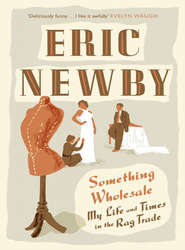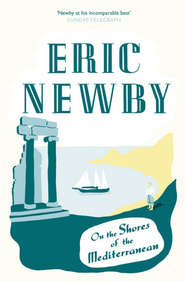По всем вопросам обращайтесь на: info@litportal.ru
(©) 2003-2024.
✖
The Last Grain Race
Настройки чтения
Размер шрифта
Высота строк
Поля
‘Tabling is a broad hem made on the skirt of the sail by turning the edge and sewing it down. It strengthens the sail for sewing on the bolt rope. You needn’t be afraid to ask if you don’t understand. I only get wild if you ask me questions like a bloody fool reporter.’
He continued: ‘In the depth I’ve got to allow for tabling at the head and the foot. There are gores in a sail too, they’re the angles cut at the ends of the cloth to increase the width or the depth. The canvas for the gores is cut on the cross, the longest gored side of one cloth makes the shortest side of the next. After the first gore is cut the rest are cut by it.’
‘Christ,’ I muttered, overcome by the Sailmaker’s command of technical and outmoded English with which he seemed equally at home as with his native Swedish. He began to explain how he found the number of yards of canvas needed. ‘It comes in bolts twenty-four inches wide. I add the number of cloths in the head and the foot together and halve them to make them square. Then I multiply the number of squared cloths by the depth of the sail and add to that the additional canvas contained in the foot gores, and linings and the four buntline cloths. The linings are sewn to the leeches and middle to strengthen it. The buntline cloths are to stop chafing on the sail. That’s why the sails are heavy. A course, that’s the big sail on the fore, main and mizzen – weighs more than a ton, and much more when it’s wet.
‘If you’re interested,’ went on the Sailmaker, ‘I’ll tell you something about sailmaking. This is my sail-loft.’ He waved his hand to indicate the austere and cramped quarters in which he worked. ‘And these are my tools: palm and needles; a sail-hook.’ He held up a small iron hook with a cord spliced to an eye in the shank. ‘Used for holding still the work. Marline-spikes for opening rope strands when I splice. A wooden fid for the same purpose. A pinker, like a marline-spike but straight, and a heaving-mallet.’ This was a hammer with a small cylindrical head used as a lever to haul tight the cross-stitches when sewing the bolt ropes on the sail.
‘What are the bolt ropes?’ I asked, having wanted to know all this time.
‘The bolt rope is sewn to the edge of a sail to stop it splitting. It’s either wire or hemp, mostly wire now. If it’s hemp it’s sewn with three-thread twine. The rope has to be well twisted while this is being done and it has to be cross-stitched on the leeches every twelve inches on every seam and at the middle of every cloth in the foot. In the head of the sail are the cringles through which the rope-yarns are passed securing the sail to the jackstay on the yard. In the foot are the cringles to which the buntlines are fastened and by which the sail is drawn up to the yard for furling.’
‘And what’s this?’ I asked him, holding up another hammer with a grooved head. ‘Another sort of heaving-mallet?’
‘It’s a serving-mallet,’ he replied. ‘And this is the way I serve a clew – which, by the way, is the lower corner of a sail to which the sheet is fastened.’
On the leech of the sail was a cringle, a ring made by working a strand of rope round an iron thimble. This cringle he hooked on to a bulkhead, hung off a block and tackle on the bolt rope where the clew was to be and set it up taut between a vertical iron post and the bulkhead. He took a ball of spunyarn, made two or three turns round the bolt rope, confining the end under the turns; he placed the serving-mallet on the rope, passing the yarn round the rope, the head of the mallet and the handle. ‘Take hold of this,’ he ordered, handing me the ball of yarn to pass round the rope as he turned the hammer which wound the yarn tightly on to the rope.
‘This is serving,’ said the Sailmaker, after he had made a few turns to show me the idea, ‘but first you must worm the rope by winding spun yarn along the contour of it to get a level surface and after that you parcel it with tarred canvas wrapped on before you serve it.
‘Now that you know how to make a sail,’ the Sailmaker went on optimistically, ‘you must know how to sail the ship. Do you know anything at all about square rig?’
I said that I knew very little.
‘Huh,’ he sniffed contemptuously. ‘Well, you’d better bloody well wake up and learn.’
He immediately launched into a long and clear exposition of the theory of square sails and the action of the water on the ship’s rudder. How, when Moshulu’s wheel was put to starboard, the rudder would go to starboard and the vessel turn to starboard; that the greater the angle of the rudder the more the ship’s way would be impeded. It was therefore important so to balance the ship with sails that only a slight touch on the helm was necessary.
‘Now suppose,’ said the Sailmaker, ‘that Moshulu has the wind on her starboard beam, that is to say at right angles to the direction in which she is heading. Sails are set on the foremast only and the yards are braced so that the sails are full. What happens? I’ll tell you,’ he said before I could open my mouth. ‘Her bows will fall off and her stern will come into the wind. That’s because she rotates on her pivotal turning point, which is forward of the mainmast when she’s trimmed properly. With sail set on the mizzen, her head will come into the wind. With sail on the main only she will go ahead, and if the yards are braced so that the wind blows on the forepart of the square sails, she’ll go astern.’
He went on for an hour and I only understood half of what he told me. Finally he lumbered to his feet, saying: ‘I’m off to see the Consul. Leave that list of English words, I’ll write down the Swedish later.’
Now he was getting restive, rummaging in a box. ‘Aw hell, I’ve got to see the Consul.’
‘Which Consul?’ I asked, wondering why he suddenly wanted one at five o’clock on a wet October night.
‘The one under the fo’c’sle head, on the port side,’ he grunted triumphantly, for he had just found a copy of the New Statesman and Nation to serve his need, and departed on this urgent mission.
Preparing sails for the Atlantic
The next morning, in spite of consultations between the Mates and the Sailmaker the utmost confusion prevailed. For winter in the North Atlantic we needed a complete suit of thirty-one storm-sails. Some of them were in the sail-loft but the rest were in the ’tween-decks mixed up with tropical sails we would need later and old blown-out rags too rotten to mend. None of the crew seemed to know which sails were wanted or where they were to be found. The sails were three and four deep in the darkness and as heavy and intractable as lead. The Mates flashed electric torches and groped for the lower leeches of the square sails on which were stencilled the name of the sail, together with the initials of the maker. There were some very old sails amongst the newer ones. One or two, of American cotton, must have been made for her before she was laid up in Seattle after the 1927 voyage to Melbourne; others were out of a well-known ship, the StarofEngland. There was also a mainsail with reef-points in it from Herzogin Cecilie, which must have been made before 1921 when she passed to the Finns, and was probably made long before 1914, at the time when she was a training-ship and cargo-carrier for the Norddeutscher Lloyd Company.
Some sails were marked in Swedish, some in English, others in German and, as each sailmaker had his own system of marking, the Mates tied themselves in tri-lingual knots.
After about half an hour of sweating and swearing, they sent for the Sailmaker. He lumbered about in the darkness saying ‘Aw, shit,’ when he tripped over some obstacle. Occasionally he borrowed a torch to consult a grubby and almost illegible piece of paper. Very soon we were heaving the chosen sails on deck: long, sausage-shaped bundles which cut into our shoulders as we tottered along the flying bridge with them.
The first sail I helped to send aloft and bend was a main lower topsail. It was stretched out across the deck and the head earrings (the ropes with which the head of the sail was stretched out along the yard) made fast to their cringles. Then the robands, the rope yarns with which the sail was bent to the jackstay, were put through each eyelet hole in the head. Next the sail was made up with its head and foot together and a gantline was rove through a block on the mast-head. One end of it was made fast to the centre of the sail, which was then hauled aloft with the help of the donkey-engine, a refinement we were not to enjoy at sea because the donkey-engine guzzled too much coal and water. Once at sea every sail was sent aloft on a gantline by hand capstan.
At the yard, clewlines, buntlines and chain sheets were ready to be bent to the lower topsail which now swung on the gantline above the yard. The sheets for the lower topsail had been cast off the cleats on the mainmast and enough chain hauled up from below to enable them to be shackled to the clew of the sail. The clewlines were shackled on and the buntlines were passed through the wooden thimbles on the front of the sail and clinched to the cringles in the bottom of the sail by a buntline knot which would not jam. The sail was now ready to be brought to the yard. Those on deck hauled away at the buntlines and those on the yard hauled on the head of the sail, one man sitting astride each yardarm to reeve the head earring through straps on the yard and haul out the head of the sail to make it quite square. The head of the sail was then made fast to the jackstay with the robands already in the cringles.
The sail was now bent, with the clews of the lower corners of the sail drawn right up to the yardarm by the clewlines and the body or bunt of the sail hauled upward by the buntlines. Now we had to furl it, as we were making a neat harbour stow. The weather leech had to be taken in first and the heavy weight of sheet and clew earring taken as far in towards the mast as possible. Next, the body of the sail was hauled up and beaten down in a neat package on top of the yard and the rope gaskets passed round both the yard and the sail, and secured.
To set the same sail one hand would be sent aloft to cast off the gaskets and overhaul the bunt and clewlines, leaving them slack. The lee sheet would be hauled down, then the weather sheet, and, on a movable yard such as the upper topsail, the yard would be raised by the hands on deck applying themselves to the topsail halliard winch. The last job for the man aloft was to overhaul the buntlines and make up the gaskets neatly on top of the yard, seizing them to the jackstays.
All this was mystifying to me. I had read of these things and, with the aid of the Sailmaker’s list, had tried to memorise the Swedish for buntlines, clewlines and so on, but it was different up in the rigging. In the fo’c’sle I might know that the upper topsail outer buntline on the port side was ‘babords övre märs yttre bukgårding.’ In practice my mind became blank. It was difficult enough to hang on and furl sail in a flat calm in dock. I trembled to think of performing these feats in the Atlantic.
7 (#ulink_c4101095-ecc0-5487-bbe9-938d086b21ee)
Wild Life in the Irish Sea (#ulink_c4101095-ecc0-5487-bbe9-938d086b21ee)
We sailed from Belfast on Tuesday, October 18th, 1938, our destination Port Lincoln for orders. On board were a crew of twenty-eight, including the Captain, a man of huge size, who had come to us from Erikson’s four-masted barque Archibald Russell.
Вы ознакомились с фрагментом книги.
Приобретайте полный текст книги у нашего партнера:
Приобретайте полный текст книги у нашего партнера:











